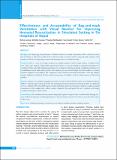Please use this identifier to cite or link to this item:
https://hdl.handle.net/20.500.14356/1390Full metadata record
| DC Field | Value | Language |
|---|---|---|
| dc.contributor.author | Gurung, Rejina | - |
| dc.contributor.author | Gurung, Abhishek | - |
| dc.contributor.author | Rajbhandari, Priyanka | - |
| dc.contributor.author | Ewald, Uwe | - |
| dc.contributor.author | Basnet, Omkar | - |
| dc.contributor.author | KC, Ashish | - |
| dc.date.accessioned | 2023-05-09T10:28:51Z | - |
| dc.date.available | 2023-05-09T10:28:51Z | - |
| dc.date.issued | 2019 | - |
| dc.identifier.citation | GurungR., GurungA., RajbhandariP., EwaldU., BasnetO., & KCA. (2019). Effectiveness and Acceptability of Bag-and-mask Ventilation with Visual Monitor for Improving Neonatal Resuscitation in Simulated Setting in Six Hospitals of Nepal. Journal of Nepal Health Research Council, 17(2), 222-227. https://doi.org/10.33314/jnhrc.v0i0.1730 | en_US |
| dc.identifier.issn | Print ISSN: 1727-5482; Online ISSN: 1999-6217 | - |
| dc.identifier.uri | http://103.69.126.140:8080/handle/20.500.14356/1390 | - |
| dc.description | Original Article | en_US |
| dc.description.abstract | Abstract Background: Improving the performance of health workers on neonatal resuscitation will be critical to ensure that the babies are effectively ventilated. We conducted a study to evaluate whether a bag-and-mask ventilation with monitor is effective in improving neonatal resuscitation practice in a simulated setting. Methods: This is a cross-over design conducted in 6 public hospitals with 82 health workers of Nepal nested over a large scale stepped wedged quality improvement project. A one-day training on neonatal resuscitation was conducted. At the end of the training, participants were evaluated on the bag-and-mask ventilation performance in a manikinbased on the tidal volume, positive end expiratory pressure and air leakage from the maskin two sessions (monitor displayed versus hidden). The comparison of the neonatal resuscitation performance with and without monitor displayed is calculated. We also conducted assessment of confidence with or without monitor of the health workers. Results: Adequacy of ventilation using bag-and-mask was better when the health workers were displayed monitor (90%) vs without monitor (76%) (p<0.01). The air leakage from the mask reduced when the monitor was displayed (12%) vs without (30%). The PEEP improved when the health workers used monitor as guide to conduct neonatal resuscitation in the manikin then without monitor displayed. The participants felt more confident performing ventilations during the visible sessions. Conclusions: The ventilation function monitor helped participants to improve their ventilation skills through realtime feedback of important ventilation parameters. Clinical evaluation of needs to be done to assess the effectiveness of the device. Keywords: Clinical performance; monivent neo; neonatal resuscitation; Nepal; ventilation monitor. | en_US |
| dc.language.iso | en | en_US |
| dc.relation.ispartofseries | Apr-June, 2019;1730 | - |
| dc.subject | Clinical performance | en_US |
| dc.subject | Monivent neo | en_US |
| dc.subject | Neonatal resuscitation | en_US |
| dc.subject | Nepal | en_US |
| dc.subject | Ventilation monitor | en_US |
| dc.title | Effectiveness and Acceptability of Bag-and-mask Ventilation with Visual Monitor for Improving Neonatal Resuscitation in Simulated Setting in Six Hospitals of Nepal | en_US |
| dc.type | Journal Article | en_US |
| local.journal.category | Original Article | - |
| Appears in Collections: | Vol. 17 No. 2 Issue 43 Apr - Jun 2019 | |
Files in This Item:
| File | Description | Size | Format | |
|---|---|---|---|---|
| 1730-Manuscript-10749-1-10-20190804.pdf | Fulltext Download | 329.14 kB | Adobe PDF |  View/Open |
Items in DSpace are protected by copyright, with all rights reserved, unless otherwise indicated.
